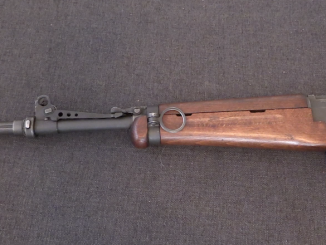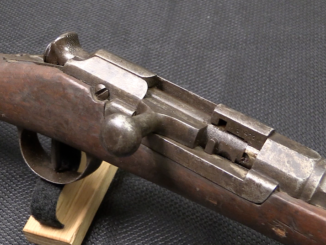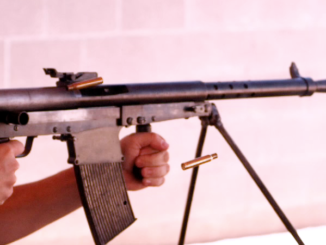Today’s Q&A is all about French guns, because I am getting close to being finished writing a book on French military rifles – the first book to cover this subject in English from the Chassepot through the FAMAS!
You can check out the cover art contest and all the other book news at FrenchRifleBook.com.
01:34 – Favorite French pistol, rifle, and machine gun
03:13 – How did I get interested in French arms?
05:05 – Lebel’s effectiveness at preventing tube magazine detonation?
07:45 – Plans to make the RSC after WW1?
10:00 – Why was French arms development overwhelmingly government and not private?
12:01 – Current arms manufacturing capacity in France?
13:30 – How does the FAMAS fit into the general bullpup timeline?
16:16 – Should the RSC have been updated to use the 7.5mm cartridge?
17:30 – Do I speak French?
19:46 – Which was better, the Lebel or Berthier?
20:35 – Why did it take so long to replace the MAS 49/56?
22:18 – Would a modern FAMAS using P-mags be feasible?
24:05 – Why did France not adopt the Maxim gun?
26:02 – Do I plan to get optics for my FAMAS?
30:07 – Why did the French adopt en bloc clips?
31:20 – What French arms are currently available at reasonable prices?
34:36 – Are there French-specific themes to their small arms?
36:35 – Would it have made a difference if France had adopted a semiauto rifle by 1939?
37:04 – What did the French arsenals do under occupation/Vichy?
38:28 – Will my book include the tabatiere?
39:17 – Should France have adopted an intermediate round in place of the 7.5×54?
40:37 – Do I have a Chatellerault M91 Mosin?
42:48 – What could be improved on the FAMAS?
44:17 – Most practical French rifle of WW1?
44:54 – Did France use the Gatling Gun in the Franco-Prussian War?
47:13 – Thoughts on the adoption of the HK 416?
50:20 – Best French rifle adopted at its time?
51:54 – Why does the French government keep WW1 and WW2 stuff classified still today?
53:54 – What was the status of the MAS-40 when WW2 started?
55:46 – Greek use of the Berthier




“Favorite French (…) machine gun”
My bet is DARNE aviation machine gun: https://www.ibiblio.org/hyperwar/USN/ref/MG/I/MG-4.html#14
– made by shotgun makers
– mechanically clever yet reliable
– high-performance for low cost
– able to fire 1600 … 1700 rpm, which is high compared to other Great War-era aviation machine gun, though to be fair most were adaptations of ground machine gun, unlike DARNE
I wonder how the Darne would compare to Rheinmetall’s MG-15. High rate of fire, flexible mounting, and chambered for the standard infantry rifle cartridge. Is the French gun more bang for your Franc?
Was it really that reliable? From what I’ve read, it was better than the Chauchat (anything was) but still not great.
The RAF tested it in 1932, I believe, and reported that it encountered regular stoppages.
“Was it really that reliable?”
Ok, I do not have paper saying we fired … bullets in conditions as follows … and observed … jams, but numerous users and long time frame it was available to purchase suggest it was at least reliable enough.
http://www.airwar.ru/weapon/guns/darne.html states that
“Darne” company from 1918 to 1931 sold 11000 machine guns, including: 2500 for Serbia, 1000 for Italy, 1200 for Spain, 150 for Brasilia, rest remained in France
Also it was used in several inter-war French aeroplanes, after MAC 1934 was introduced, popularity of Darne in French military aeroplanes was declining, but it was still widely used in naval aviation aeroplanes yet during 2nd World War, for example see Latécoère 298.
Sorry about 51.54 the military ammo are no more (with a few exceptions, naturally, otherwise it would not be french law) a distinctive fractor , so that WWi and WWI guns are , for most , like sporting rifles and, in general , ammo not pointed particularly
31:20 – What French arms are currently available at reasonable prices?
LMAO, ALL French arms have gone up by at least a couple hundred dollars or more in the last 2 to 3 years, and continue to go up and up. I refer to this as “The Ian Effect” or “The Forgotten Weapons Effect”. I am just glad I started collecting French rifles several years ago. The internet in general and this awesome enterprise of Ian’s have shined a light on a gun collecting niche where there used to be just a handful of us. But all of the information sharing is priceless, so I shall not complain (Well, too much anyway). Keep up the good work Ian!!!
Ian, thanks for the french Q&A and all the best with the book. On the matter of the French mutinies in WWI, do you have any recommendations for books that covers this aspect well?
Two books on the subject are: “Dare Call it Treason: The True Story of the French Army Mutinies of 1917”, by Richard M. Watt & “Between Mutiny and Obedience: The Case of the French Fifth Infantry Division during World War I” by Leonard V. Smith. Have you read either of these? If so, any good? Thanks.
Writing this while waiting for my french plumber to show up. French plumbers are like all plumbers always late
Anyway on the table in front of me are 2 flatnosed lebel cartriges my wifes grandfather bought back from the ww1
They are lined up nose to tail and according to my measurments the flat tip of the bullet touches the base of the bullet in front of it at 10.5mms below the top of the cartrige rim
According to my measurments the bottom of the recessed ring surrounding the primer is 10mms from the top of the cartrige rim
The flat base of the bullet itself is about 4.5mms in diametre
So there is a safty margin of around .5mm to prevent the cartrige tip impacting the primer
Technical french and gun mags are easy but I realy learned french from the Maigret books lots of spicy stories there
“(…)learned french from the Maigret book(…)”
PROJECT GUTENBERG offers free books to download, without breaking copyrights so generally these are older (I am not sure how France work but generally after 100 years of author’s death copyright expire). Available books in français: https://www.gutenberg.org/ebooks/search/?query=l.fr
If you want to search by language simply put l.internettopleveldomain for example l.it (Italy) or l.es (Spain), to search by author use a.name for example a.verne, you might use both at one time, for example a.verne l.fr query will give books of that author in français.
Ian,
Rumor has it you have an Mle 1878 Kropatschek. Please say it is true. I’ve been trying to either examine one or find a video of one being examined for a long time. (well, that or an 1884 Kropatschek – the Army version.) If you do, I wait with patiently yet impatiently.
Terry
I couldn’t take my eyes off the clamityware mug. Lol
Steyr maybe an other option for a bigger military contract
My list:
Favorite French pistol? I kinda agree with Ian here… Chamelôt-Delvigne Mle. 1873 double-action revolver… Also appears in quirky French film _Delicatessen_. Favorite pistol? Manufrance “Le Français” Type Armée in 9x20SR Browning long. Although I’d sure like a MAC 50!
Favorite French rifle? Hmm. I sure like the MAS Mle. 1936! I also rather like the FSA 1949/56!
Favorite French machine gun? Hotchkiss Model 1914.
Brown Bess or Charleville? Charleville!
Most avant-garde French firearm? Fusil-lance Mle. 1854 de l’escadron des <>. Surround yourself with a “century” of bodyguards on horseback. They have the world’s first small-bore cartridge rifle (Well, OK, maybe the credit goes to the Swiss? Still, a 9mm at a time when the regular line infantry caliber was 17.8mm?!), with a huge sword bayonet that easily doubles the length to serve as a lance. To operate: pull the breech lever, which uses the trigger guard as a motive spring like an underhammer rifle, until the breech is open and the rifle is cocked. Insert an odd-ball copper pin-fire cartridge that has a little extractor affixed to the top, opposite the percussion pin. Aim the rifle with the rear sight admirably close to the rear of the receiver and close to the eye. This will help you ignore the copper cartridge case staring at you from the open breech! When the trigger is depressed, the breech snaps shut at the simultaneous moment the pinfire cartridge is detonated! To reload, repeat, but pluck out the empty cartridge case.
http://armesfrancaises.free.fr/Mousq%20Treuille%20de%20Beaulieu%20mle%201854%201er%20type.html
Fave French SMG: MAS 38, Hotchkiss CMH2 (encroyable!), MAS 48C3, and the prototype designed by Petter, designer of the 1935A pistol!
http://www.armeetpassion.com/petter.html
Honorable mention?
The Gnôme-et-Rhone Sten gun is pretty cool, what with vertical wooden foregrip to keep one’s hand away from the reciprocating bolt and ejection port, and positiviely “Volkssturm” quality wooden butt stock!